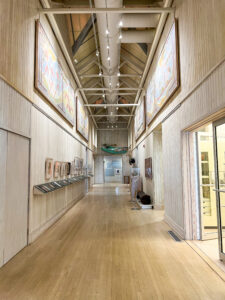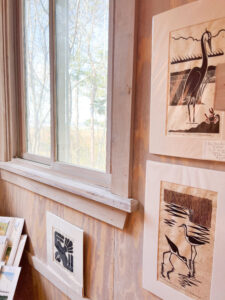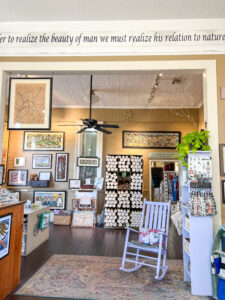
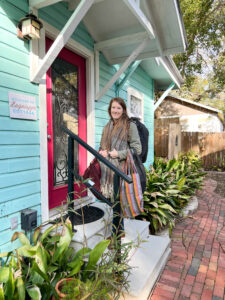
My favorite professor in college taught a Travel Writing class. I was obsessed with traveling, but I worried that I hadn’t traveled anywhere worth writing about. One of my classmates had spent the past several years circumnavigating the world in a small boat with her family. (Yes, really.) One of my friends who I met through the class hiked the Appalachian Trail before college and then took a semester off to hike the Pacific Crest Trail from Mexico to Canada alone. It felt like everyone in my class had spent time jaunting around other continents to places that sounded impossibly exotic to me. I’d only flown on my first plane a few years before when I was 17, and I’d never been overseas. What could I possibly write about?
But my professor taught us that travel writing is about the way you look at the world, not about how far you go to reach the destination. He had us write about our hometowns, places we loved, and places we were familiar with. It was an important lesson not only regarding travel writing but also in how I came to think about travel as a concept. I spend so much time now thinking about and planning international trips that I’m sometimes guilty of overlooking the places waiting to be discovered closer to home. There are so many worthwhile places to explore that don’t require a plane ticket or months of saving.
I grew up about an hour from the Mississippi Coast, so I’d never really thought of it as a vacation destination. But other people have started to. USA Today named Ocean Springs and Bay St. Louis the #1 and #2 “Best Costal Small Towns” in America in 2022. I hadn’t visited Ocean Springs in years, so I knew I needed to go see what all the fuss was about. My sister and I brought our mom to the Spring Arts Festival in Ocean Springs for her birthday last year, and I knew I wanted to go back as soon as I could for a long weekend to fully explore all the town had to offer.


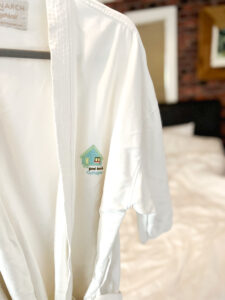

So a couple weekends ago, I headed to Ocean Springs, just an hour and a half from my home in New Orleans, for a stay at Front Beach Cottages. The cottages sit a couple blocks from the beach in their own enclave where they share a covered deck with a firepit, a collection of bikes and kayaks (free for guests to borrow), a golf cart guests can rent, and a friendly cat. There are four cottages, three of which were built as fishing shacks in the 1940s, all renovated and decorated with unique themes. I stayed in the Lagniappe Cottage—a New Orleans themed studio with a kitchenette, an incredible shower with two shower heads, and the most comfortable king size mattress I think I’ve ever slept in. They allow dogs in two of the four cottages, and if it hadn’t been the coldest weekend of the year, I’d have brought Chewie with me.
Every cottage has its own special features that make me want to go back and stay in each of them. The Bellande Cottage has two bedrooms, a pullout couch, and a full kitchen—perfect for a family. The Key West Cottage has its own private deck with a giant hammock. The NOLA Cottage has a beautiful free-standing bathtub that I would read in and never leave. All the cottages have outdoor showers (in addition to their indoor showers), which would be perfect after a day on the beach.

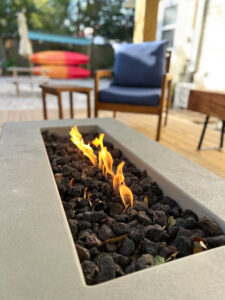
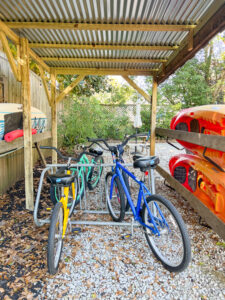
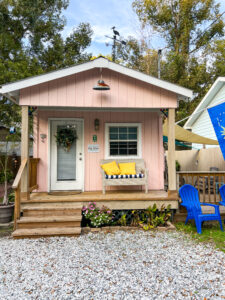
Bridgette Aultman, who owns and manages the cottages along with her husband Mark, chatted with me by the fire pit as acorns fell on the deck roof. The two of them purchased the cottages five years ago from the previous owner who moved away. We chatted about Ocean Springs, the Mississippi Coast, and how much growth there’s been since Hurricane Katrina. There were couples staying in two of the other cottages who came to say hi while we chatted. Bridgette greeted them each by name, asked one of the women how she was feeling because she knew she’d had a cold, and told me about how one couple’s beloved dog had recently passed away. “It sounds like these are family members instead of guests,” I told her. She shrugged it off and said they get a lot of repeat guests who they get to know over the years. I know why they keep coming back. I cannot recommend this place enough.
The beach sits a couple blocks away. It’s a quiet beach, devoid of the loud bars or flashy casinos of neighboring Gulfport and Biloxi. Here, the beach was only populated by dog walkers, runners, and teenagers huddled around a firepit. Fishing boats floated in and out of the harbor on one side of the bay, and I watched the sunset on a public pier against the backdrop of Biloxi.
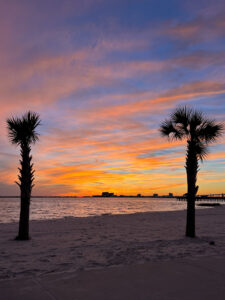
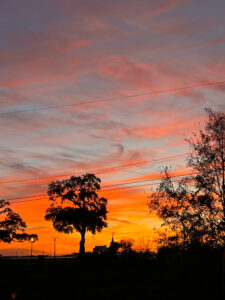
A few blocks in the other direction sits the historic downtown. It’s full of the things you expect to find in small-town Mississippi (sweet tea, cute cafes, boutiques) and a lot of things you wouldn’t expect (a vegan soap store, a fine dining restaurant with a fixed-price 5-course menu, a speakeasy-style bar with a swinging book-case door). People drive golf carts or ride their bikes around town. You can walk anywhere downtown from the cottages in less than 10 minutes.
There are few places in America where you can find better food than the Mississippi Coast (and I say this as a resident of New Orleans—America’s greatest food city). At The Lady May, I sat at the bar and ate two crab cakes the size of hamburger patties and became so full that I had to waddle back to the cottage and lay down. At Glory Bound, I ate falafel practically the size of tennis balls, and then I lost all control of myself and ordered a slice of baklava cheesecake for dessert (in spite of being lactose intolerant). The men sitting at the bar next to me may have thought that I was there to watch the football game with them, but I was only there for gluttony. I have no regrets.




I thought I’d stop briefly in the Walter Anderson Museum, the town’s most popular attraction, but I ended up staying for hours. I’d heard of the artist Walter Anderson because nearly everyone who grew up in Mississippi has heard of Walter Anderson, but I knew very little about him. The museum was incredible. They did a fantastic job of creating a place that I imagine is equally captivating for those who know very little about Walter Anderson and those who are life-long Anderson scholars. The museum hosts regular events and workshops and operates as a sort of community space for all ages. It’s well-worth going out of your way to visit this place, and I imagine that Walter Anderson would love knowing that his art has brought people together in this way.
I don’t live in a city where I feel comfortable walking alone at night, and it felt so refreshing to visit a place where the noises I heard in the dark were most likely the possum I saw in the tree outside. People sat on their front porches and nodded as I walked by. I woke up early to read and write and wander while the streets were quiet, happy to find a place that felt comfortable and new at the same time. Amtrak has recently announced that it plans to re-open its route between New Orleans and Mobile for the first time since Hurricane Katrina, and I am so excited for the new visitors who will soon start to discover the Mississippi Coast for themselves. I love learning that places I assumed I knew can still surprise me.
